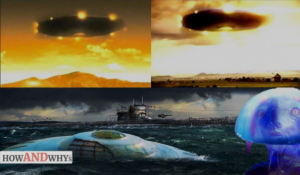Scientist Says Rogue Planets May Be Massive Alien Spaceship & Evidence Of Aliens Surveilling Earth Soon To Be Revealed

Scientists around the globe have been searching for the sign of extraterrestrial life in the vast universe. The ideal place for the discovery of alien life is considered planets orbiting within the habitable zones of their stars, where liquid water might exist. But a new study have proposed an alternative way where there is a possibility that super-advanced intelligent beings might be using rogue planets (free-floating planets without a host planetary system) to travel to other planetary systems.
The concept of “Cosmic Hitchhikers” is proposed by Irina Romanovskaya, a professor of physics and astronomy at Houston Community College. Her study “Migrating extraterrestrial civilizations and interstellar colonization: implications for SETI and SETA” proposes that extraterrestrial civilizations might have produced possible technosignatures and artifacts by using free-floating planets for interstellar migration and interstellar colonization, as well as strategies for the search for their technosignatures and artifacts.
Romanovskaya discussed a hypothetical scenario of a free-floating planet approaching the Solar System. She said: “There are no traffic lights in the Galaxy. If the Solar System happens to be in the way of some free-floating planet, the planet will not stop at the red light. It will fly right through the Solar System. The probability of such an event would depend on how many free-floating planets exist in our Galaxy, which at that time remained to be estimated.”
As an example, she discussed star GJ 433 which experienced a close flyby a few thousand years ago. “If a civilization migrated during the closest approach of GJ 433 and the binary system a few thousand years ago, then by the time of the current observation, the civilization would have spent a few thousands of years on its new home planet, creating atmospheric technosignatures and other terraforming signatures on the planet it colonized,” she added.

Obviously, rogue planets may not have life-nourishing stellar energy. Romanovskaya points out that these worlds may still be habitable, especially if they contain the kind of subsurface oceans that are suspected to exist in a few bodies within our own solar system. Moreover, these planets offer many advantages as interstellar vessels, compared to the traditional vision of artificial generation ships — ark-like spacecraft intended to host many generations of a population — that must be laboriously constructed by space-faring species.
Read also:
- Oxford Scholar Believes Two Cosmic Wars Happened In Our Solar System Between Advanced ETs
- Ex-NASA Scientist Discussed Evidence Of Alien Visit & Exposed Government UFO Cover-Ups
- Turkish Mayor Claimed Gobekli Tepe Is Not A Creation Of Humans, Perhaps Aliens
- Aliens From Andromeda Told US Army Personnel That Humans Are Composite of 22 different E.T. races
Technosignatures produced by extraterrestrial civilizations
Extraterrestrial civilizations’ biological species, post-biological species, or their technologies become Cosmic Hitchhikers when they ride free-floating planets to reach, explore and colonize planetary systems. Romanovskaya recommended that the search of for free-floating planets should be made in the regions where unexplained emissions of electromagnetic radiation or unusual cosmic phenomena are detected.
She explained that technosignatures produced on free-floating planets may be mistakenly interpreted as technosignatures originating in planetary systems, groups of stars, galaxies or empty regions of space. This may occur when at the time of observations, a free-floating planet is located along the line of observations of a planetary system, group of stars, galaxies or empty regions of space. Later, the technosignatures may not be detected along the line of observations because the free-floating planet moves away from it.
The recently-launched James Webb Telescope picks up infrared radiation, Romanovskaya said, which would be emitted by a rogue planet that’s been retrofitted into a spaceship. Unmanned probes could also join the search. “NASA has already sent spacecraft to travel to the outskirts of the Solar System and beyond,” she noted. “Perhaps, in the not-so-distant future, another spacecraft will be sent to the remote regions of our planetary system to study any newly discovered objects that might be captured free-floating planets.”
Romanovskaya also proposes that Earth’s neighbors could bear traces of aliens that came across our solar system in the past, perhaps in the dried-up remains of Mars’ oceans.
New research might show evidence of non-terrestrial objects surveilling Earth
Irina Romanovskaya has strong points to confirm that an alien civilization might have trespassed on our solar system in the past. If that is the case then hypothetically speaking, they might have put their objects near Earth for surveillance.
Beatriz Villarroel of the Nordic Institute of Theoretical Physics and Stockholm University has undertaken a citizen science effort to search for evidence of such non-terrestrial artifacts in what some might consider an unusual place: data that has already been publicly available for decades.

Prior to the launch of manmade satellites like Sputnik 1 in the late 1950s, Earth’s skies were free of the clutter that hinders modern searches for prospective non-terrestrial objects.
According to Villarroel and her team, one way to overcome this problem is by scanning earlier photographic plate projects such as the First Palomar Sky Survey (POSS-1), which is the focus of the Vanishing & Appearing Sources during a Century of Observations (VASCO) project.
Villarroel and several colleagues published a paper, “A glint in the eye: Photographic plate archive searches for non-terrestrial artefacts,” which elaborates on how potentially anomalous non-terrestrial objects might be located.
Although surveying photographic data from pre-satellite times offers obvious benefits to the search for non-terrestrial artifacts, there are challenges for modern researchers using this approach, since multiple glints in older sky survey imagery could be accounted for by a number of other things. These could include defects in the images that produce the appearance of star-like objects which, in fact, may simply be photographic artifacts.







